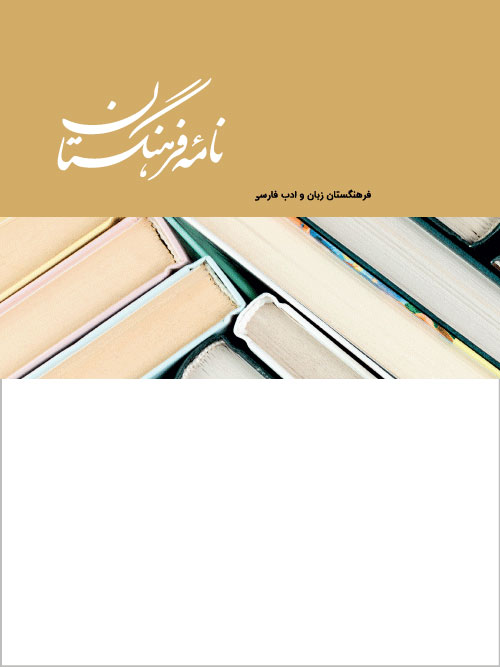فهرست مطالب

نامه فرهنگستان
سال هفدهم شماره 2 (زمستان 1397)
- تاریخ انتشار: 1398/01/27
- تعداد عناوین: 10
-
- سرمقاله
-
صفحه 3
- مقاله
-
صفحه 11
-
صفحه 31
-
صفحه 89
- نقد و بررسی
-
صفحه 121
- دیدگاه
-
صفحه 138
-
Page 11
Manteq-ot-Teyr (The Conference of Birds), written by Attâr of Nishâpur (Farid od- Din Attâr) at the beginning of the 7th century (AH). It is a famous allegorical and mystical narrative rhyming couplet poem with 4700 verses that has been textually criticized and published many times. There have been so many beneficial arguments on the core principle of this poem, its mystical niceties, and its linguistic merits. Despite the fact that the language used by Attâr, especially in this work, is easy and clear and almost free of any literal complexity, there are verses in it needing more reflection that could shed light on some aspects of this esteemed book, that is one of reading sources in university courses. It can also present some beauties in Attar’s language. In this article, we discuss only some of the verses.
Keywords: Attar, Manteq-ot-Teyr, Textual criticism -
Page 41
There are some Arabic couplets in Sa’di’s Golestân logically composed according to Arabic prosody, but nearly all Persian emendators have wrongly edited them based on Persian prosody; this wrong method has caused some mistakes in their emendations. There are not however such mistakes in two Arabic translations as well as in one Turkish commentary of Golestân simply because these Arabic couplets are emendated correctly based on Arabic prosody rules. In this paper the correct editions of the couplets and also the wrong editions are introduced and classified.
Keywords: Sa’di, Golistân, Arabic, Persian Prosody, Comparative Metrics -
Page 73
The Maqâsed ol-Owliâ fi Mahâsen ol-Anbia manuscript is written by Mahmoud Fâryâbi, an author in sixth century (AH). It provides a biography of the Prophets and some stories of their lives in form of a literary narration. This book has never been textually criticized and published before. The text moves away from a simple and easily read narration becoming more of a medium technical discourse in form. Rich vocabulary, metaphorical expressions, immense novel and poetic phrases, different homonymies, allusions, homophonies, phonotactics, analogies, inlays, artistic application of Qur’anic verses and sometimes their tactful interpretation, abundant pictures, rhythmic and fluent language, etc. are all among the remarkable instruments that are used to elevate the poetic features in this text, giving it an astonishing artistic and literary value. Based on the facts stated above, the authors in this article are trying to extract the main characteristics of the text from its various pictures and expressional and literal complexities, using concept analysis and research method, and provide a ground for introduction of this lesser known text for the researchers and those of interest. Due to the fact that Faryâbi writes the text to be an amendment on the works of others, the stories stated, except for complete stories of Yosef Prophet (peace be upon him), Mohammad Prophet (P.B.H) and Moses Prophet (P.B.H), other stories are all short and concise in form. The plot narration and expression of meaning is not ruined by the rhetoric; and rhythmical and some long sentences does not take the form of wearful verbiage. On the contrary, the aspects of words and meanings are all in quite moderation.
Keywords: Maqâsed ol-Owliyâ fi Mahâsen ol-Anbiyâ, Faryâbi, literary stylistics -
Page 89
In this article, we investigate the views of Abouhelâl Askari, the Iranian man of letters in the forth century (AH), on the form and meaning in language, based on his two books Alsanâ’ateyn and Alforugh al-loghaviyeh. In the Alsanâ’ateyn he maintains that form and meaning are separated, relating the former to rhetoric and the latter to eloquence. He repeatedly insists on the importance of correct and simple meaning and also beautiful form; despite the fact that this view may seem contradictory and cause confusion in the reader weather to consider more importance to form or meaning. Meaning, in his view, is an arbitration or will of the mind and form would be correct if it is in accordance to that. Moreover, in understanding the meaning, not only simplicity of meaning is important, but also we should consider the articulator, the hearer and the placement of pauses. In the Alforugh ol-loghaviyeh (that is in principle a dictionary on stating the differences between seemingly synonymous words) he shows that he does not believe in complete synonymy. He first considers repetition and apposition to be evidence of lack of complete synonymy, then provides eight morphological, grammatical and semantical standards to identify the differences between seemingly synonymous words. We, However, can find some cases in which he does not follow his own views.
Keywords: Abouhelâl Askari, Alsanâ’ateyn, Alforugh ol-loghaviyeh, homonymy, form, meaning, synonymy -
Page 109
The epic-historical narrative poem, Shahanshâhnâme, by Ahmad Tabrizi, is one of the histories for Mongolians that is written in 738 (AH), in the Persian language in tone and style of Ferdowsi’s Shâhnâme. One of the most remarkable characteristics of this book is great effort of the poet to purify Persian, which distinguishes it from other prose and rhymed works in Persian placing it as the only rhymed work and the first full text written in pure Persian. In this article, we first assess the claim of Ahmad Tabrizi on writing a totally Pure Persian narrative poem. Then, we compare Persian language purification process in Tabrizi’s work and ferdowsi’s Shâhnâme, so that Tabrizi’s amount of fidelity to pure Persian writing becomes more clear. After that, the poets motivations for writing a totally Persian narrative poem are presented, which shows his passion and affection for Iranian identity and his effort to preserve Persian. After a concise investigation in pure Persian writing history, the unique position of Tabrizi’s Shahanshâhnâme is discussed.
Keywords: Epic-historical narrative poem, Ahmad Tabrizi’s Shahanshâhnâme, pure Persian writing, Ferdowsi’s Shâhnâme, Arabic

